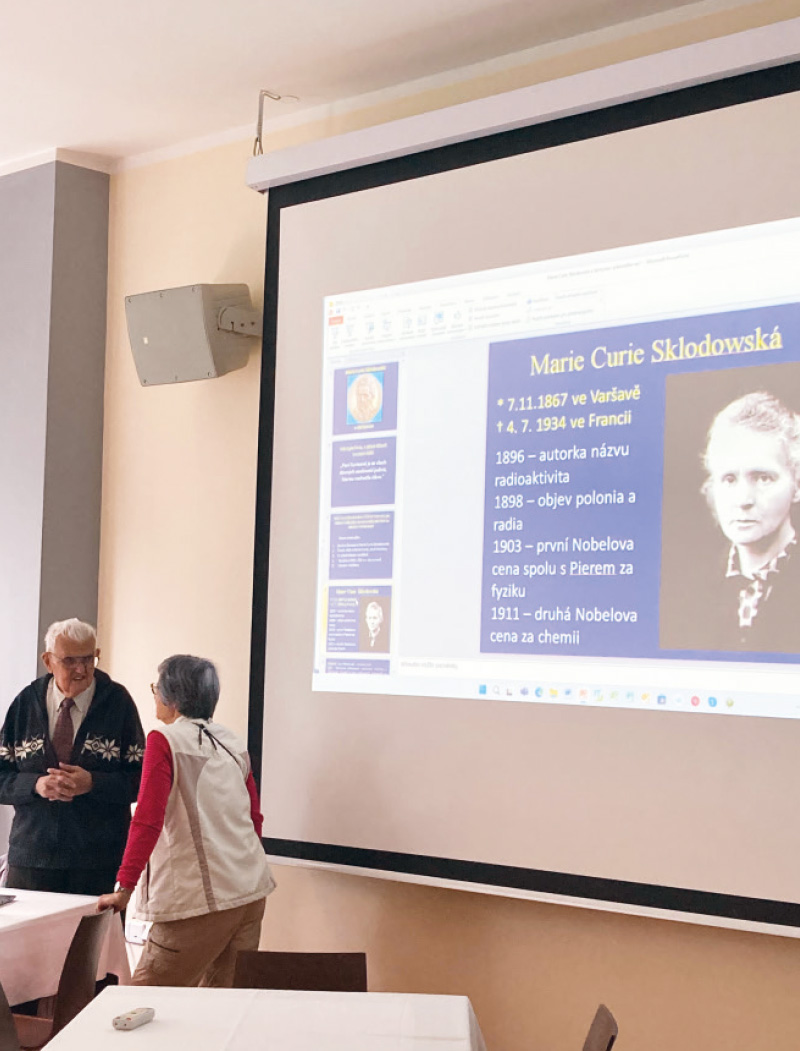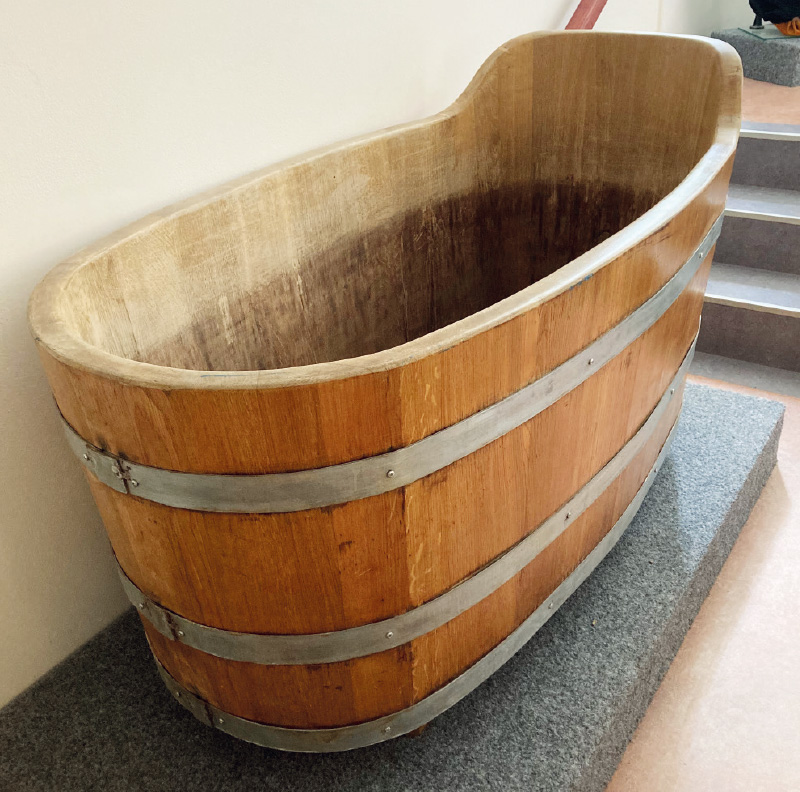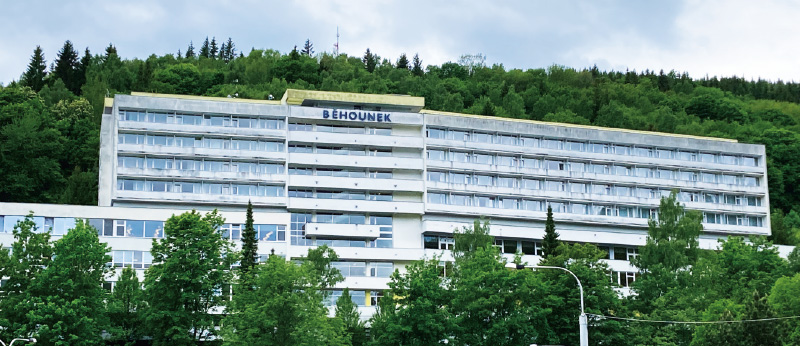The town of Jáchymov in the Ore Mountains foothills is part of the Karlovy Vary Region and is situated near the border with Germany. As mentioned in this year’s April issue of VTEI [1], covering 51 km2 and with less than two and a half thousand permanent inhabitants, it is the smallest, and perhaps therefore sometimes neglected, member of the West Bohemian spa family. However, Jáchymov offers a very specific treatment; thanks to the high concentration of radon in the local natural mineral water, the world’s first radon spa was established here and is still operating successfully today.
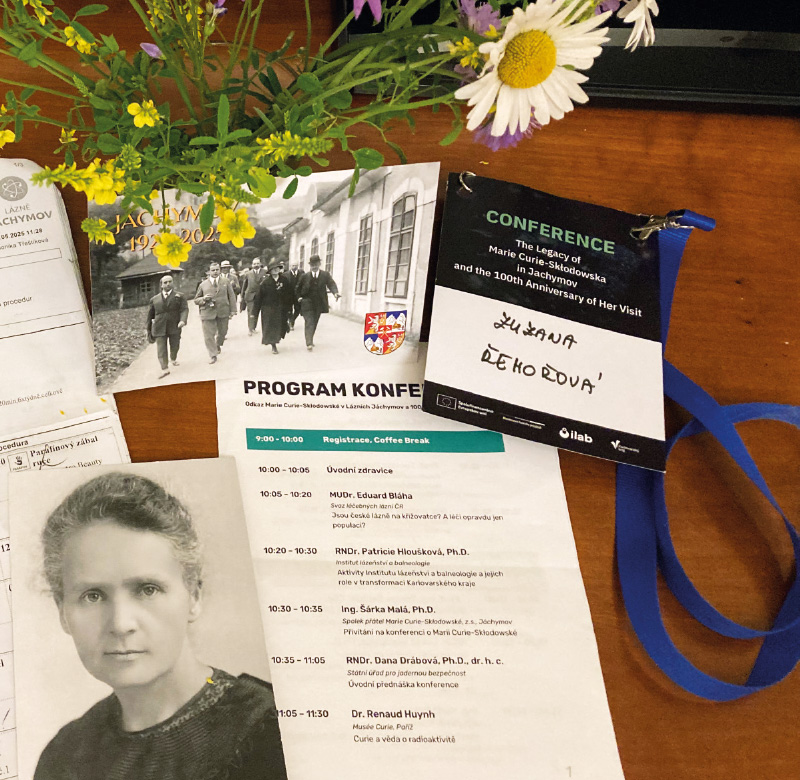
Glimpses into Jáchymov’s History
The story of the Jáchymov region, a landscape lying beneath the massive ridge of Klínovec (Fig. 1), began hundreds of millions of years ago, when various ores and minerals flowed into rock fissures and were deposited there in the form of veins. The richness of some of these deposits led early 20th-century regional historians to simplify the past of the landscape into an age of silver and an age of uranium. The former also included the mining of lead, bismuth and cobalt, while the latter encompassed the era of radium [2].
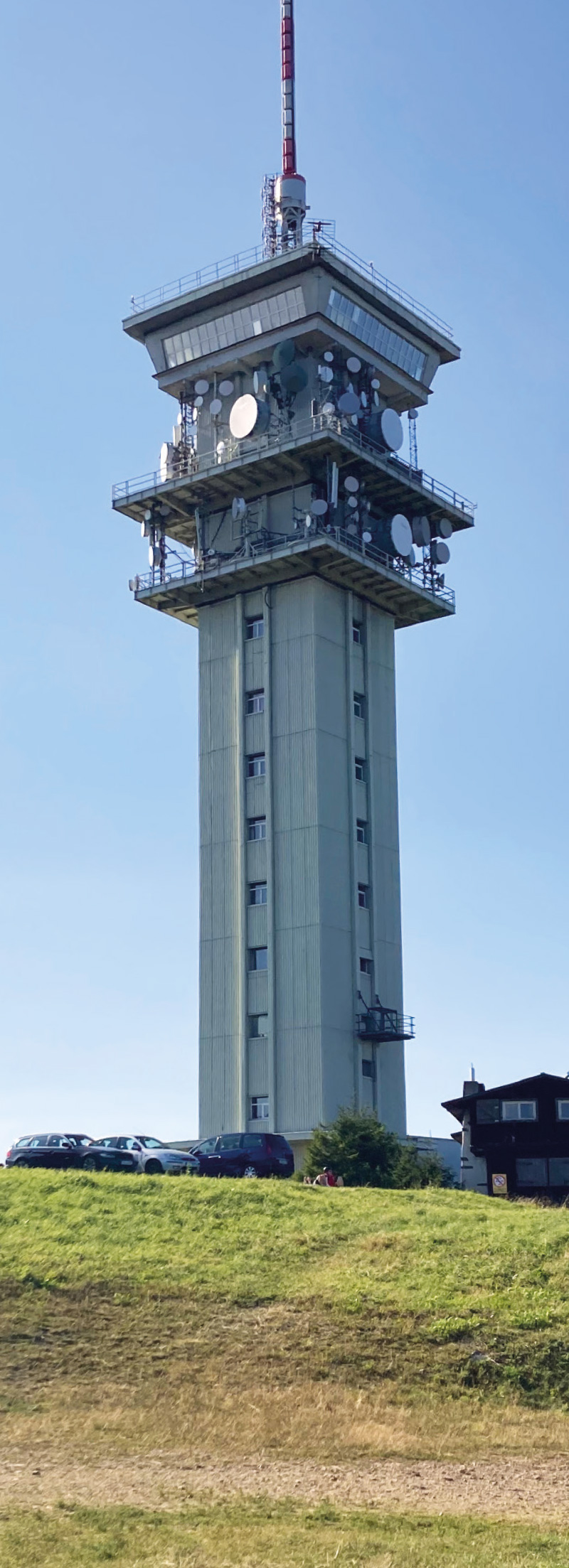
Fig. 1. Klínovec TV transmitter
The growing European market at the end of the 15th century, combined with a shortage of gold coins in circulation, created a kind of “hunger for large silver coinage”. [2]. Its minting and entry into the market depended on the quality and quantity of raw material sources. Neighbouring Germany had long excelled in silver mining at that time, but as the reserves of this precious metal were gradually depleted, a “silver rush” began to grow on the Bohemian side as well. The first discoveries of silver in 1512 were almost incredible (the ore veins were very close to the surface and silver was even found in the roots of uprooted trees) and testified to great wealth. At that time, the owner of the Ostrov estate, Count Štěpán Šlik, took over the mining business in the Jáchymov region. He demonstrated the entrepreneurial and diplomatic skills of his ancestors by forming an association of like-minded feudal lords, establishing links with the finance houses in Augšpurk (now Augsburg, author’s note) and Nuremberg, raising the necessary capital and thus being able to buy the land from the previous owner to lay the foundations for the future mining district. He subsequently invited the best mining experts, and from 1516 onwards, the previously insignificant and unknown settlement of Konradsgrün became a mining town, with its original name gradually disappearing. As a town of several thousand inhabitants, it was then given the noble name Sankt Joachimsthal (St. Joachim’s Valley). The explanations given by local chroniclers and historians for the presence of Joachim/Jáchym in the name are more than logical – near the border on the German side, mining towns dedicated to Anna, Joseph, and Mary already existed, so this was essentially a way to complete the Holy Family.
Mining and the associated development of extraction technologies experienced unprecedented growth, which was even reflected in the Šlik family coat of arms (Fig. 2). It is estimated that between 1516 and 1554, more than 250,000 kg of silver was mined in Jáchymov [3]. Mining activities were also associated with increased wood consumption, as well as the development of industry and trade. When Jáchymov was elevated to a free mining town in 1520, its permanent population had already reached nearly 5,000. Thirteen years later, the population had grown to 18,000, making Sankt Joachimsthal the second-largest city in Bohemia after Prague and one of the most populous cities in Europe at the time [3].
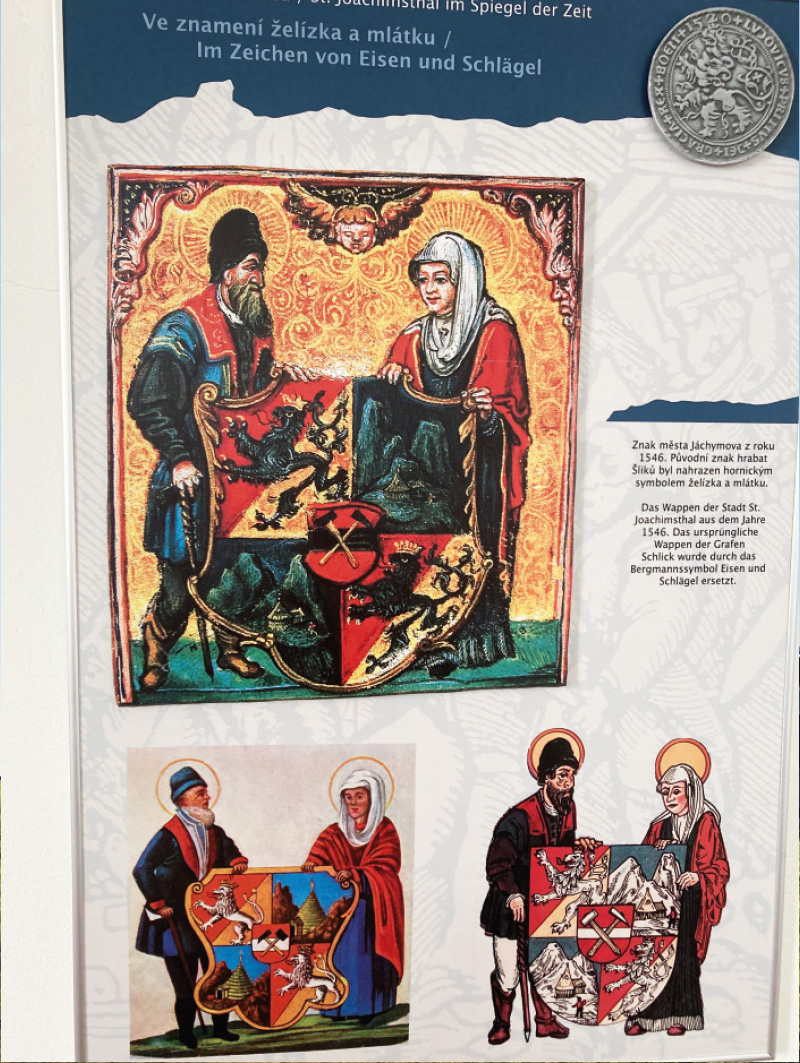
Fig. 2. Changes in the Šlik family coat of arms
With the development of the city, trade flourished, and so in 1520, the aforementioned silver coins began to be officially minted here, thanks to Count Štěpán Šlik.
Since the Šlik family was of German nationality, the coin was given the Upper German name ‘joachimsthaler’. The name was shortened to thaler or taler (in Czech ‘tolar’). Cross-border trade flourished in the Middle Ages, with Czech tolars (Fig. 3) valued for their high silver content; they reached various parts of Europe and influenced the names of many other coins (e.g. in Poland, Hungary, Italy, and the Netherlands). From there, they made their way to America, where they became known as dollars. Today’s American dollars are thus named not only after the Czech currency but directly after the silver tolars of Jáchymov [3]
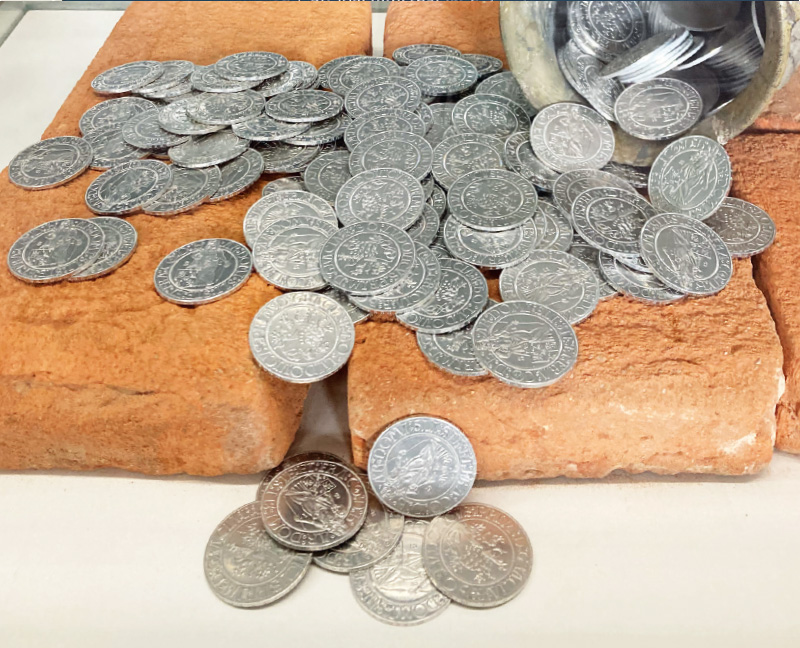
Fig. 3. Jáchymov thalers
The boom years of Jáchymov in the 16th century are still evidenced by the town hall buildings (the original Šlik Palace) and the Mint in the upper part of the town (Figs. 4, 5). The Royal Mint is now a museum with a permanent exhibition dedicated to the history of silver mining and coin minting, the city’s dark past linked to uranium mines and political prisoner camps in the 1950s, up to the present-day radon therapy. The tour also includes extensive underground passages. Directly opposite the town hall, on today’s Náměstí Republiky (Republic Square), stands the still-functioning Krušnohorská Apothecary, which continues the tradition of the original herbal pharmacy. It was founded in 1520 and became the first pharmacy in Bohemia. To this day, it sells only purely natural handmade products from the Ore Mountains (Fig. 6).
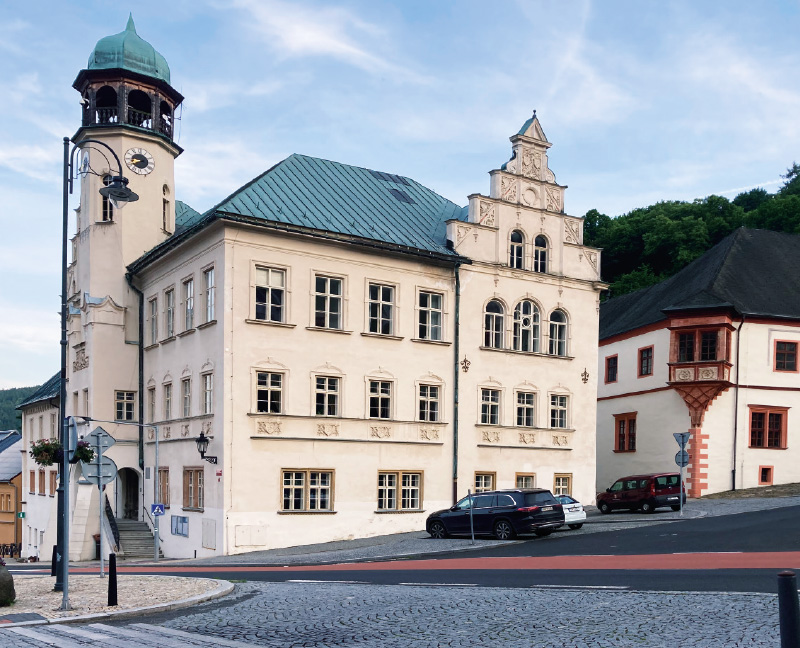
Fig. 4. Town hall and museum today
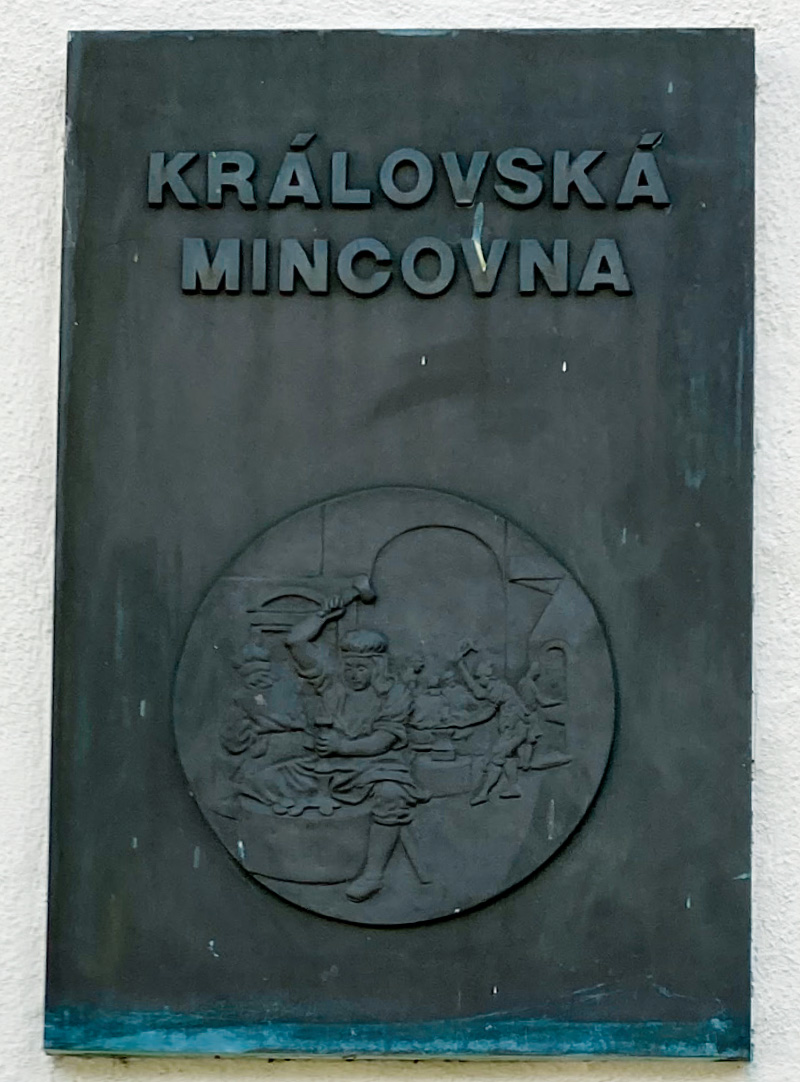
Fig. 5. Emblem of the original Royal Mint
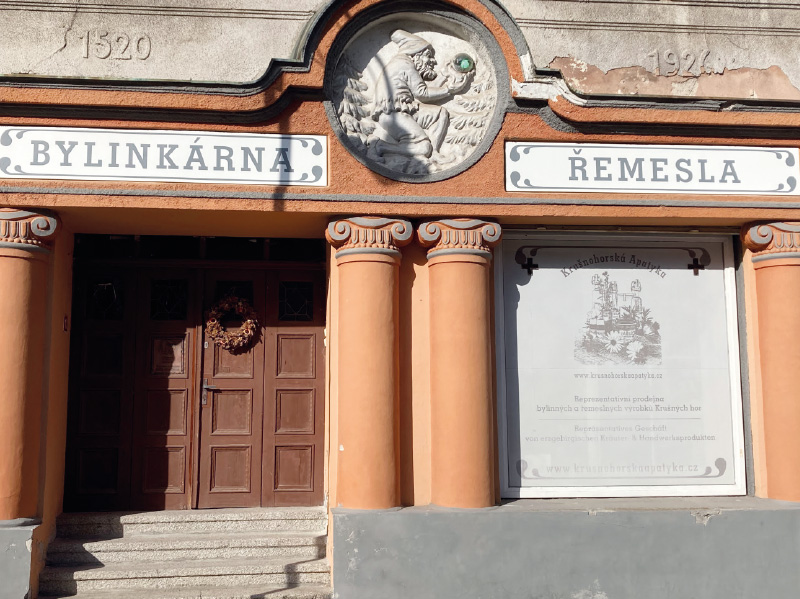
Fig. 6. The first Czech pharmacy was established in Jáchymov
The deposits of silver-bearing ore in Konstantin mine (today’s Svornost mine, author’s note) (Fig. 7) and in other mines gradually diminished, and extraction from ever greater depths became increasingly challenging both technically and financially. Demand for silver on European markets was also slowly declining. Mining activity waned, the mines yielded diminishing returns, and miners began leaving in search of better deposits. The population decreased, and Jáchymov entered a period of decline. It experienced a modest revival in the 18th century, when attention shifted from silver to other metals, especially cobalt, which was used in a local factory to produce colours for glass and porcelain. The town gradually began to come back to life. But the best was yet to come.
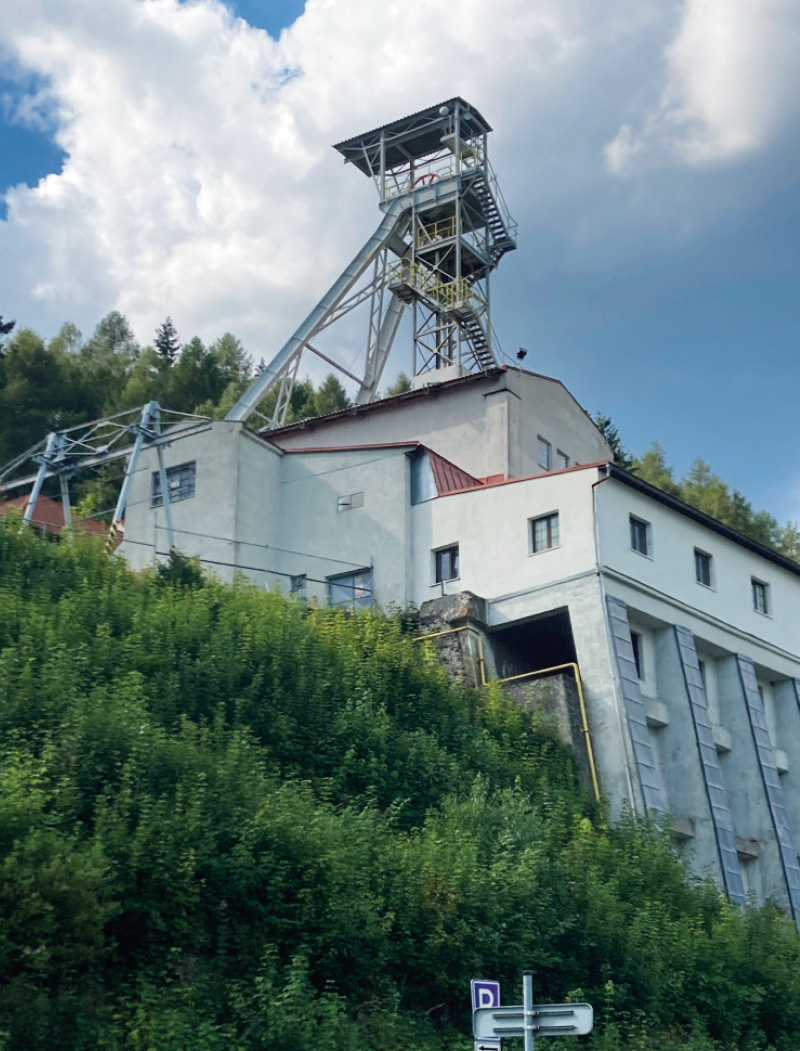
Fig. 7. Svornost mine
Marie Curie-Skłodowska
Marie Curie-Skłodowska (1867–1934), an extraordinarily gifted and intelligent woman who, despite adversity, attained a university education and became a world-renowned scientist, has become a symbol of Jáchymov’s modern history. She was born in Warsaw, which at the time belonged to the Russian part of Poland, as the youngest of five children. She lost her mother at the age of just 12. After finishing secondary school, she yearned for further education, which was, however, denied to women. That is why she attended the so-called ‘flying university’ (Uniwersytet Latajacy), which, according to historian and Jáchymov patriot Ing. Jaroslav Ochec, meant that the students met in a different apartment each time (Fig. 8) [4]. In 1891 she left Poland and moved to Paris, where she continued her studies at the Sorbonne. She was the first woman in history to earn doctorates in physics and chemistry there, later also in mathematics. Her research focused primarily on uranium and radioactivity, and during her work, she met her future husband Pierre, who was then a doctoral student in Henri Becquerel’s laboratory, specializing in magnetism. They then worked together, resulting in the discovery of polonium (July 1898), a new element which Marie named after her native Poland. In December of the same year, she discovered another element, the highly radioactive radium. For this achievement, Marie, together with her husband Pierre and colleague Henri Becquerel, won the Nobel Prize in Physics in 1903. And it did not end there. In 1911, the Royal Swedish Academy of Sciences awarded her the Nobel Prize in Chemistry for the isolation of pure radium. This time she received the prize alone, as Pierre had died in 1906.
Fig. 8. Ing. Jaroslav Ochec after his lecture
Jáchymov pitchblende
But let us go back to Jáchymov. The year 1898, already noted for the discovery of the new elements polonium and radium, also marked the first contact the Curies had with the Czech lands and with Jáchymov. Both elements were isolated from waste material provided to Marie and Pierre by the local uranium pigment factory. After four years of effort, the couple succeeded in obtaining one-tenth of a gram of the newly discovered element, radium. With this historic achievement, they laid the foundations for a new era of human knowledge, and brought the name of the town of Jáchymov to wider attention [2].
Any thoughts of limiting or even shutting down the unprofitable Jáchymov mines were immediately abandoned. As the Curies continued their research, they required increasing amounts of mining waste – first kilograms, then hundreds of kilos, and eventually tonnes. This valuable waste material was pitchblende (uraninite, or uranium oxide), a black mineral that miners, even during the silver rush, referred to simply as ‘smolinec’ (from the Czech word ‘smůla’, meaning ‘bad luck’, translator’s note). They believed that it was bad luck because, whenever they came across it in the mines, it was clear that the silver vein had ended and only pitchblende was to be found further down. So the pitchblende had to wait more than 300 years for its moment of glory.
Preparations for the industrial production of radium and radium compounds near the raw material source began in Jáchymov relatively soon. The first gram of pure radium was produced at the Jáchymov factory in 1907. Annual production eventually reached as much as five and a half grams of radium, which at the time accounted for a significant portion of the world’s supply [2]. Interest in radium grew alongside the unfolding possibilities of its applications. Let us set aside for now the somewhat mad era of the radon craze, when trade in the element was booming and radon, admired for its fascinating radiation, was added to everyday consumer products – such as soaps, perfumes, cigarettes, and ink – long before its harmful effects were understood (see the photo from the international conference on the 100th anniversary of Marie Curie Skłodowska’s visit to Jáchymov, taking place in Jáchymov on 12–14 June; Fig. 9) [5], and instead turn our attention to its healing properties. These, after all, marked the beginning of a new chapter in the town’s history.
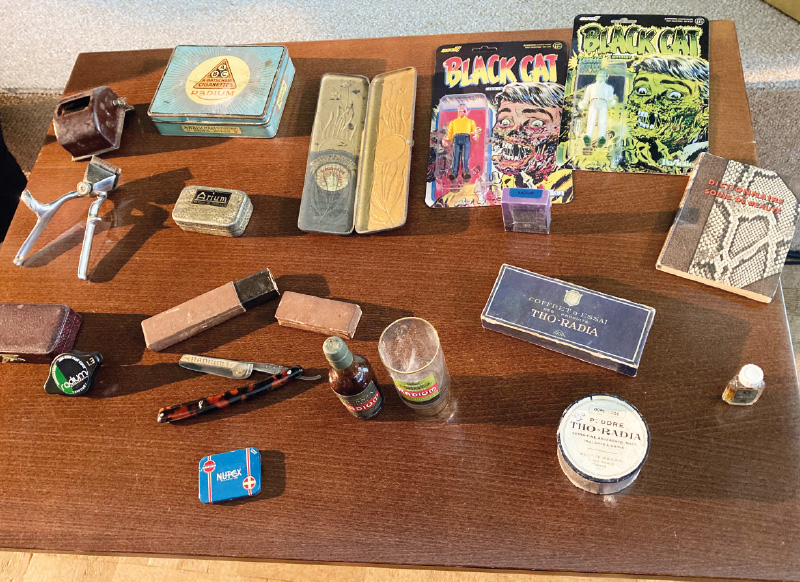
Fig. 9. Objects preserved from the time of radon fever
The valley of the ‘water of life’
As early as at the beginning of the 16th century, miners were aware of the healing effects of the mining waters in Jáchymov. After work, they would go into the flooded parts of the shafts not only to wash themselves but also to relax, and they soon realised that the mine water had a beneficial effect on their weary bodies and relieved their pain. This is also documented in the writings of their physicians [3].
The first attempts to establish a spa in Jáchymov were very modest. Initially, the local baker Josef Kühn provided bathing facilities in house No. 282 on the square (now Republic Square, author’s note), where the district physician Dr. Leopold Gottlieb, who had his office in the same house, set up two bathing cabins. Josef Prennig, a retired miner, brought him healing water from the springs discovered in the Werner mine in a covered wooden tub (Fig. 10). At that time, it was not yet clear exactly what the bathing process did for these first patients, but the healing power of the ‘water of life’, as it came to be called, was already unquestionable.
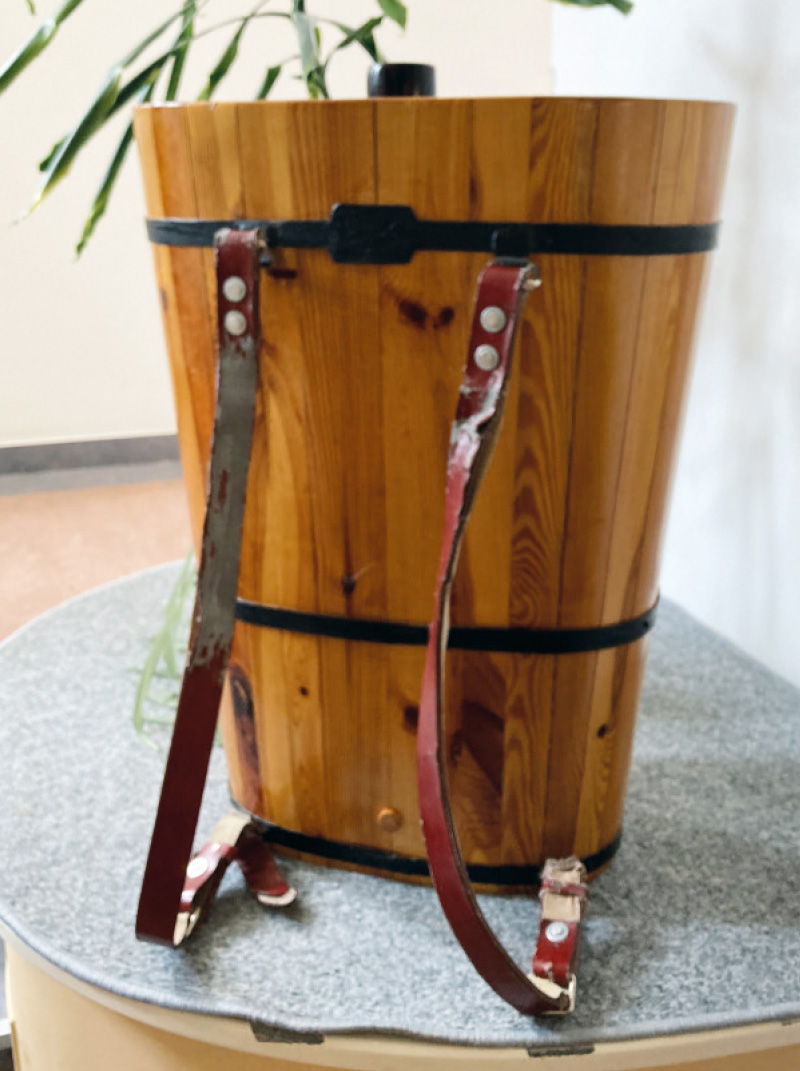
Fig. 10. Model of Josef Prennig’s back bucket
The world’s first
The radioactivity of the mine springs was not scientifically verified until 1905 thanks to the research of the Curies. After that, nothing stood in the way of efforts to build a spa in Jáchymov. In the uranium pigment factory building, space was allocated for additional bathing cabins (Fig. 11), which among other things involved constructing a four-kilometre-long pipeline to supply radioactive water to them. It can thus be said that Marie and Pierre Curie were at the birth of the local spa; the official beginning is said to be in 1906. While Pierre tragically died under the wheels of a horse-drawn carriage in April that year, and Marie thus lost not only her colleague but also her husband and father of their two young daughters, Irène and Ève, a small private spa wase established in Jáchymov. And, thanks to the truly unique mineral water enriched with radon, it became the first radon spa in the world.
Fig. 11. Wooden tubs were used for bathing
As the number of spa guests grew, it became necessary to build respectable accommodation for them. The first spa building was the Kurhaus in 1911 (today the central part of the Agricola Spa Centre; Fig. 12). The neoclassical building with elements of Viennese Secession (a form of Art Nouveau) was, at the time, the first spa institute of its kind in history. Kurhaus had a capacity of 40 bathing cabins, and a spa forest park was created around it, which to this day stands out for its meticulous landscaping and beautiful secluded spots (Fig. 13). Today, the Agricola building has been extended on both sides and serves as an aqua centre and mine themed sauna for the public (Fig. 14).
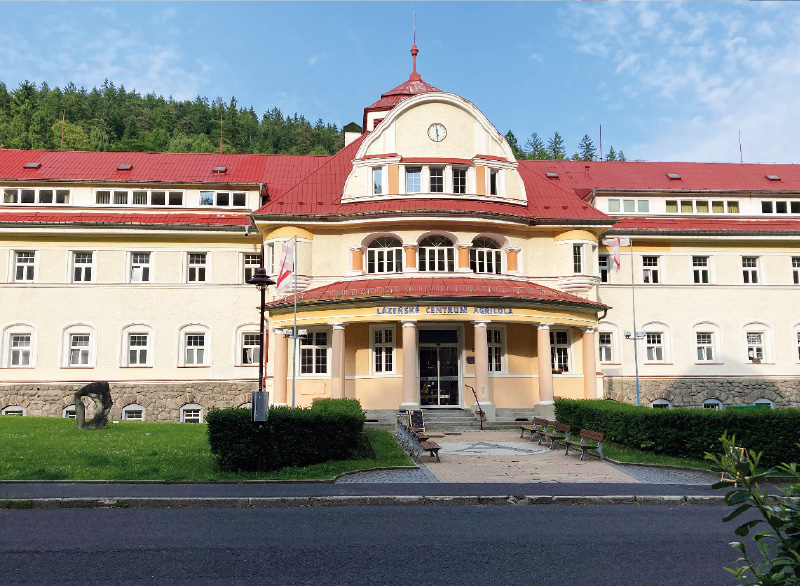
Fig. 12. Agricola spa centre
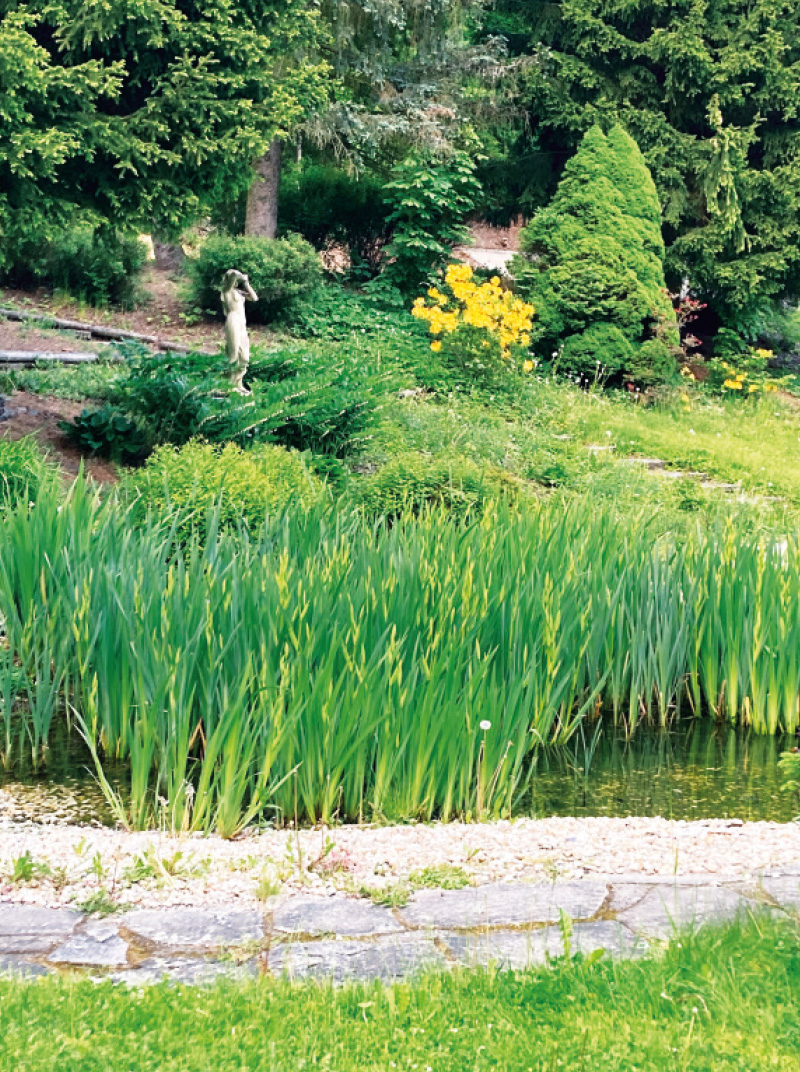
Fig. 13. Forest park with a pond
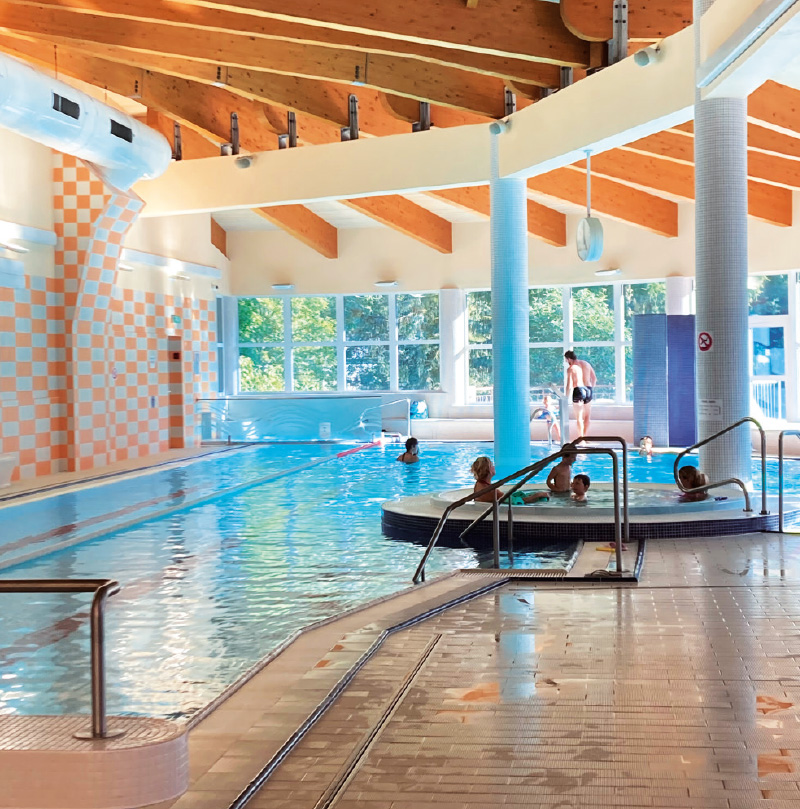
Fig. 14. Pool in Agricola
The pride of town called Radium Kurhaus
Frenzied construction activity continued, and Jáchymov began to transform into a spa town. Local entrepreneurs were also active, building additional guesthouses and hotels near the first spa building, the most famous of which remains the Astoria Hotel (Fig. 15). At the same time, a joint-stock company was established in Jáchymov, bringing together prominent figures from the high aristocracy and Viennese industry, headed by Arnošt Emanuel, Count Silva-Tarouca. In 1912, the grand hotel and sanatorium Radium Kurhaus (now the Radium Palace, author’s note; Fig. 16) was officially opened, offering patients everything under one roof – accommodation, dining, and spa treatments. With its refined architecture and sensitive integration into the Ore Mountains landscape, it became the pride and symbol of Jáchymov and soon of the entire Ore Mountains region. Equipped with the most modern technical innovations of its time, it was from the outset aimed primarily at wealthier clientele and foreign guests (Fig. 17). The very first seasons after its opening promised that the return on investment would come within a few years. In the 1920s, the area in front of the building was redesigned, and an ornately decorated terrace with a colonnade and balustrades was added (Fig. 18). Nearby, tennis courts and a woodland café were established. Radium Kurhaus became one of the most luxurious hotels in Europe, attracting numerous world-renowned personalities. Among its guests were British King Edward VIII, Egyptian King Fuad I, German composer and conductor Richard Strauss, and writer Karl May, the creator of Winnetou. Notable Czechs who frequently stayed there included President T. G. Masaryk (after whom the main spa street is still named), Karel Čapek, and later President Václav Havel.
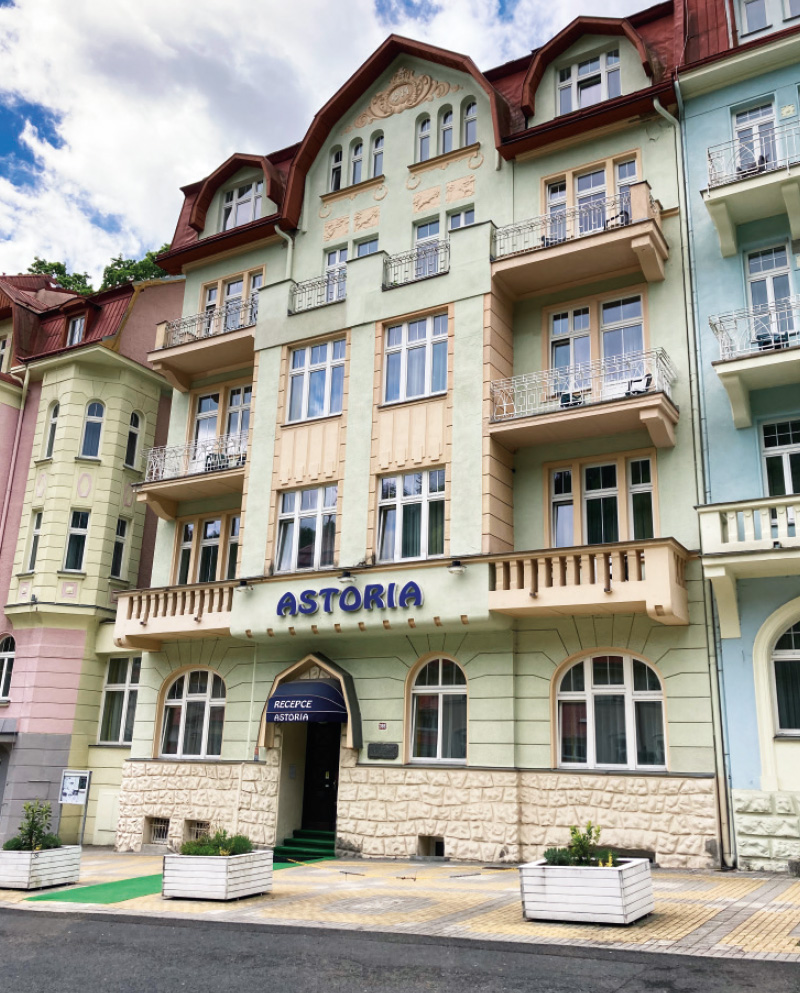
Fig. 15. Astoria Hotel
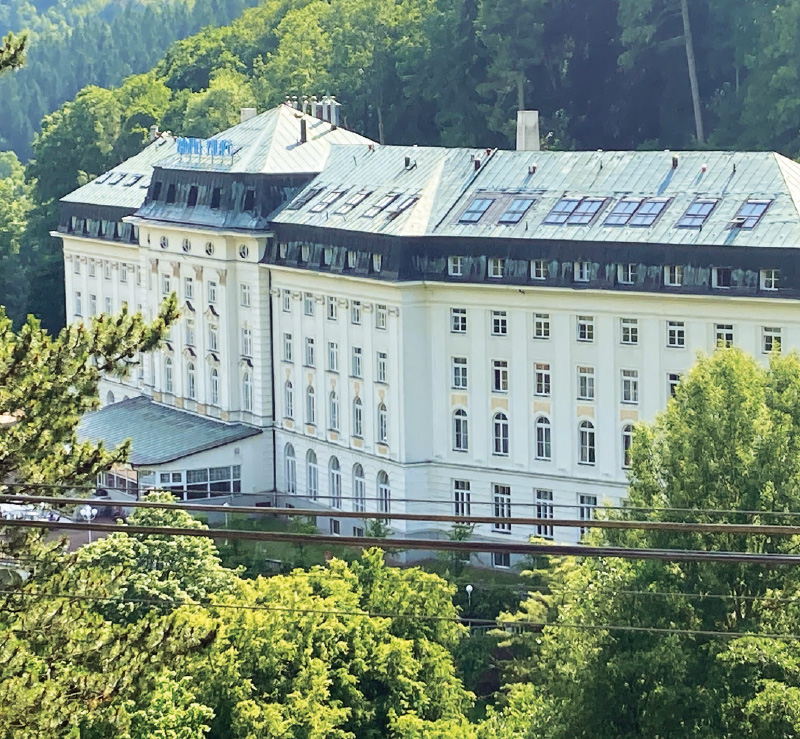
Fig. 16. Radium Palace

Fig. 17. Staircase on the hotel ground floor
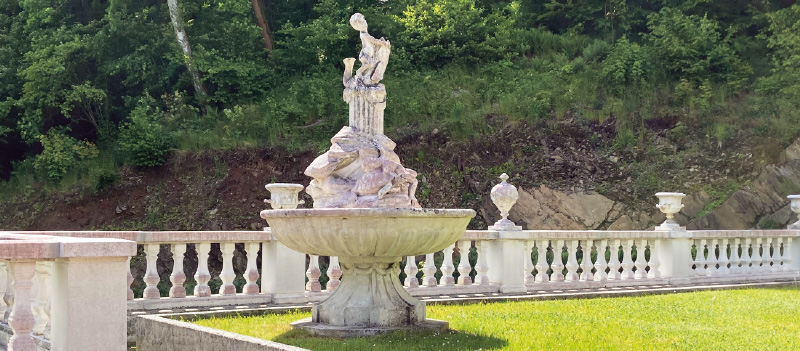
Fig. 18. Richly ornamented balustrades
However, one world visit is still remembered in Jáchymov today. In June 1925, Marie Curie Skłodowska, who literally stood at the cradle of radium, radioactivity and the unique treatment here, visited the town. After a brief stop in Prague and Lány, where she met President T. G. Masaryk, she arrived in Jáchymov and stayed at the Radium Palace Hotel (Fig. 19). She toured the spa and the radiology centre, descended into Svornost mine, and also visited Klínovec.
This June marked exactly 100 years since that historic event, and to commemorate the anniversary, the aforementioned international conference was held in Jáchymov [5]. Among the speakers were, for example, Dr Dana Drábová, Chair of the State Office for Nuclear Safety (Fig. 20), Ing. Martin Přibil, Head of Svornost mine (Fig. 21), MUDr. Jindřich Maršík, MBA, Chief Physician of the Jáchymov Spa (Fig. 22), and many other distinguished guests. A letter from Hélène Langevin-Joliot, the 97-year-old granddaughter of Marie and Pierre Curie, was also read out during the conference (Fig. 23). Later that evening, a wooden bench engraved with Madame Curie’s name was ceremoniously installed in front of the Radium Palace entrance, and two rose bushes bearing Marie’s name were planted in the bed in front of the bench. How fitting – when she met President T. G. Masaryk in Lány, the media described their meeting as being “in the right place at the right time”. It is as if, here in Jáchymov and at the Radium Palace hotel, the two-time Nobel laureate still lives on.
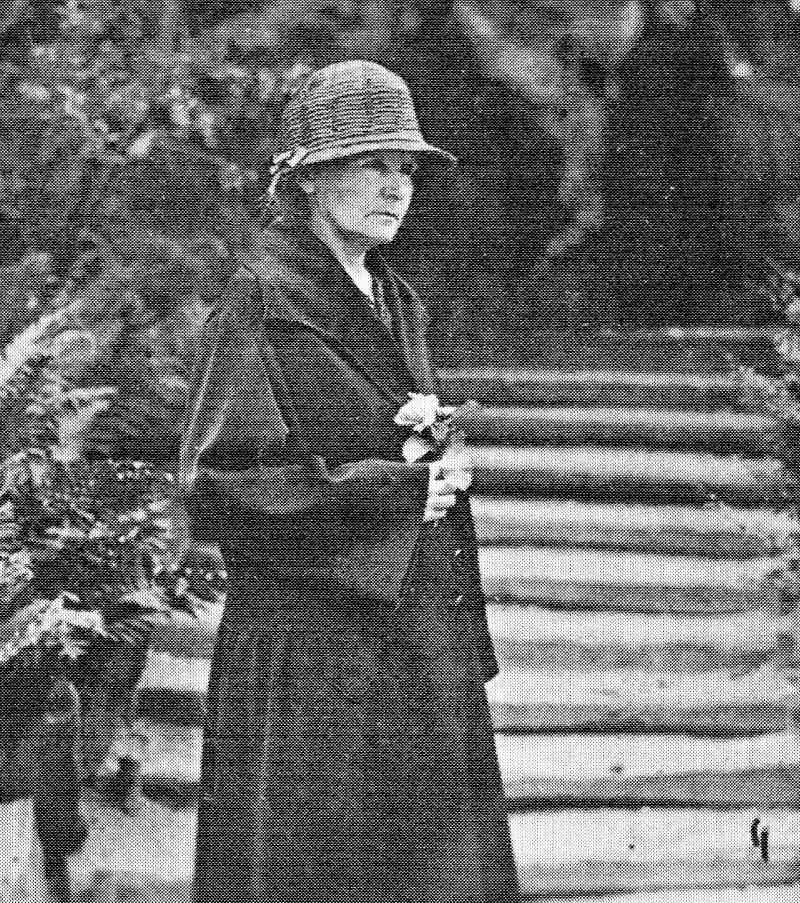
Fig. 19. Photo of Marie Curie-Sklodowska, unpublished in Czech media, taken in June 1925 in front of the Radium Palace Hotel (a gift to the author from the archive of Ing. Jaroslav Ochec)
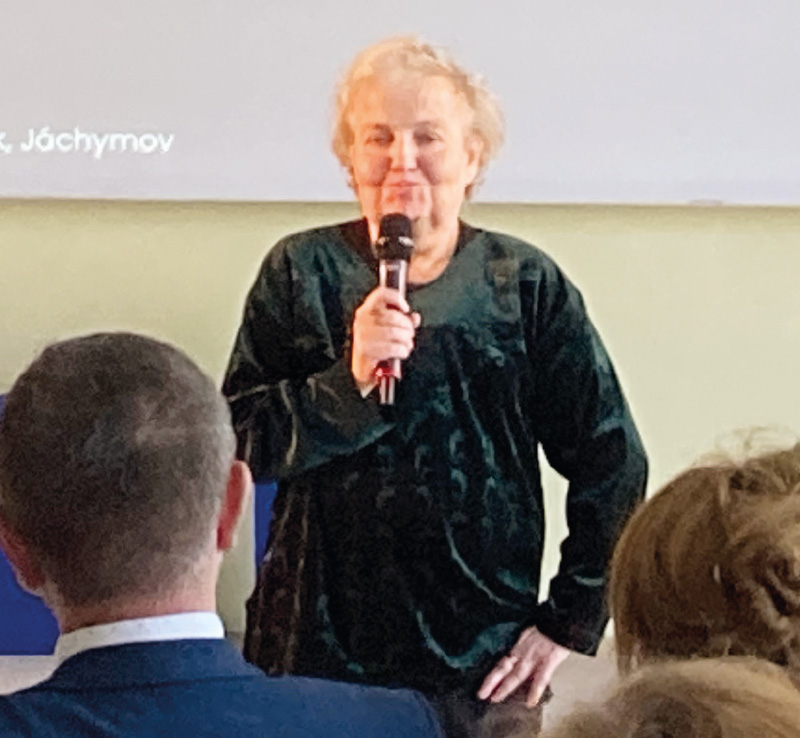
Fig. 20. Dr. Dana Drábová
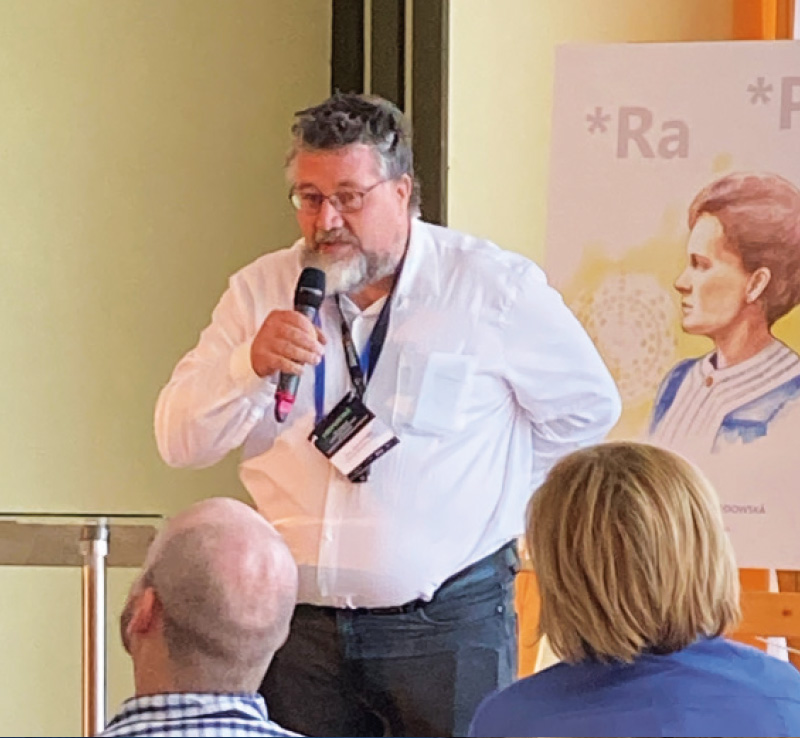
Fig. 21. Ing. Martin Přibil
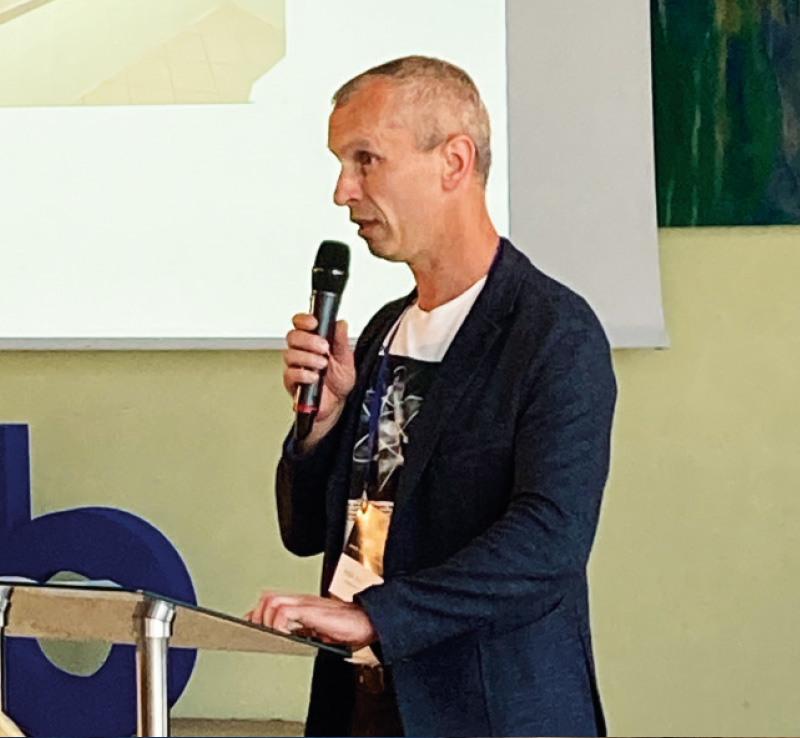
Fig. 22. MUDr. Jindřich Maršík, Chief Physician of Jáchymov Spa
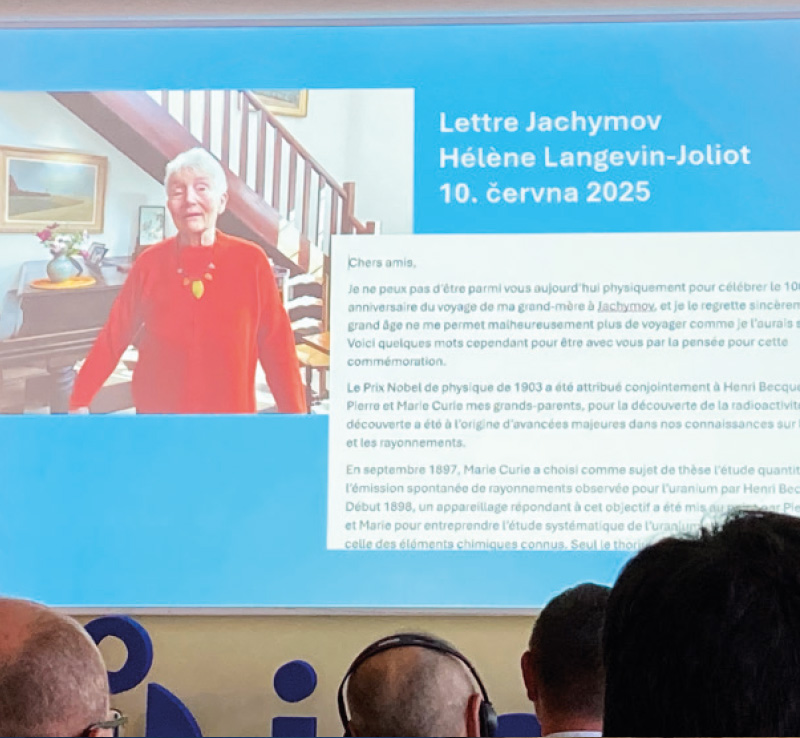
Fig. 23. A letter from the Curies‘ granddaughter
New treatment houses
In October 1975 another treatment house was opened in Jáchymov. It was named Academician Běhounek Sanatorium (now Běhounek, author’s note; Fig. 24) after František Běhounek, a prominent Czech physicist and chemist, who researched radiology and was Marie Curie-Skłodowska’s guide during her trip to Jáchymov in June 1925. In July 1992, an institute bearing the telling name Curie was officially opened, significantly transforming the area around the spa crossroads (Fig. 25). Both buildings are very modern and also offer their clients everything under one roof – accommodation, dining, and treatments. However, the popularity of the Radium Palace hotel endures, and its interiors (Fig. 26) as well as its surroundings still offer the charm of the ‘good old days’ (Fig. 27).
Fig. 24. Běhounek spa house
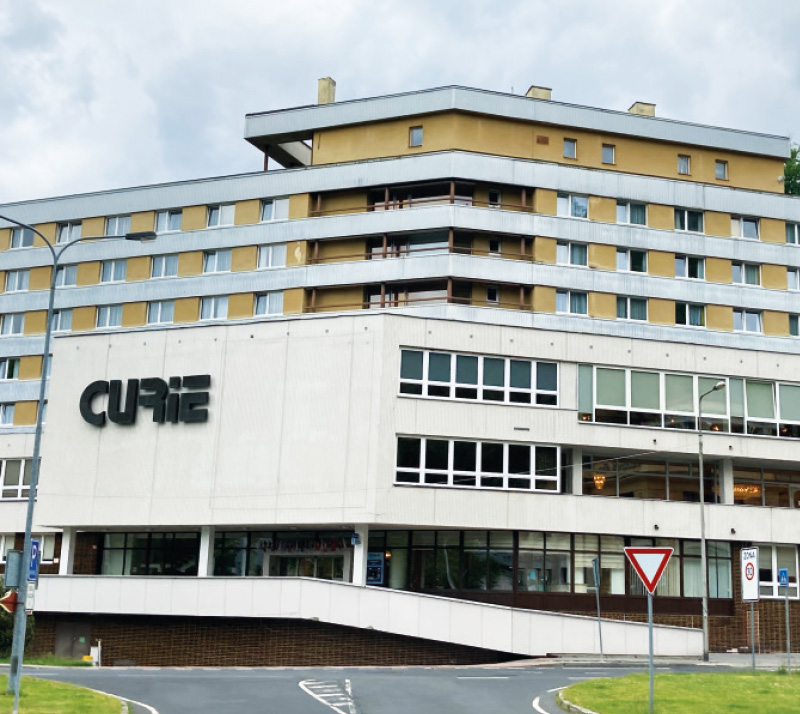
Fig. 25. Curie spa house
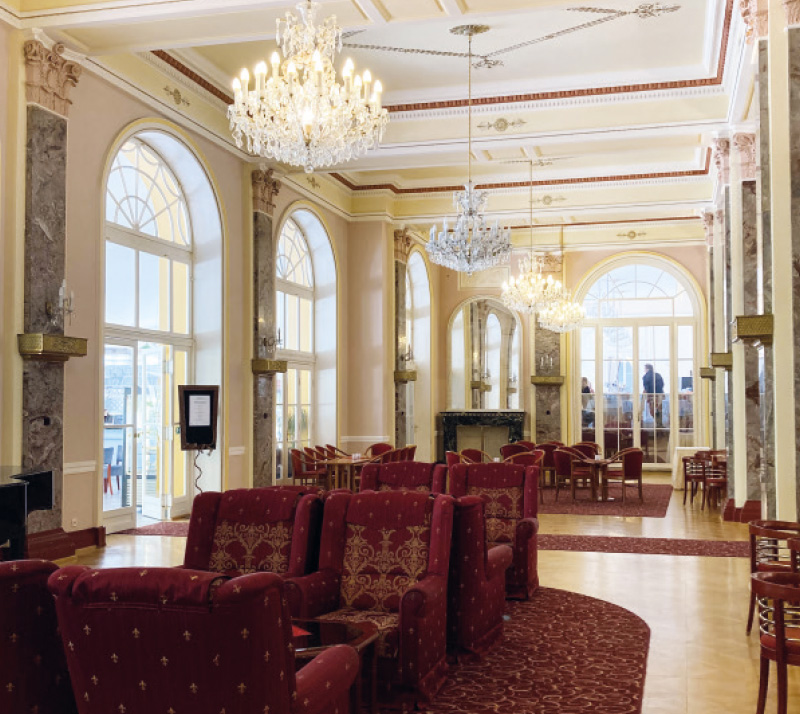
Fig. 26. Radium Palace lobby
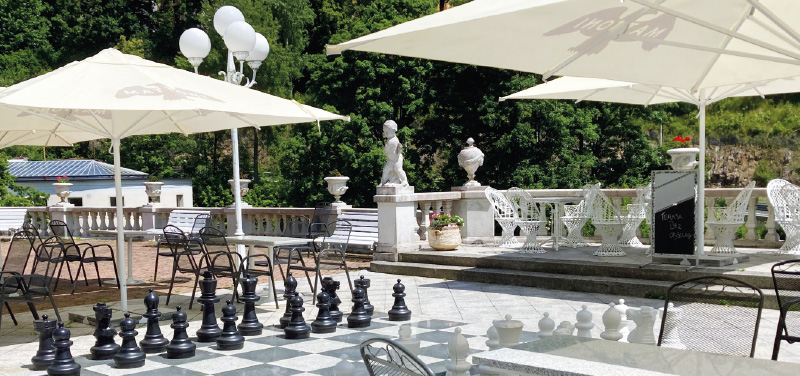
Fig. 27. Part of the summer terrace floor is a chessboard
Jáchymov radon therapy
What exactly does radon therapy involve? Shouldn’t we be afraid of radon? According to the chief physician of Jáchymov Spa, MUDr. Jindřich Maršík, MBA [6], the most important factor is, of course, the dose. While high doses of radiation can have fatal consequences for humans, small doses can actually be beneficial. After all, the entire planet Earth and life on it originated under much higher levels of radiation than today. There are places, such as the geological substratum beneath Jáchymov, where the natural radiation background is higher. However, clients of the Jáchymov spas are not at risk because they typically stay for around two to four weeks. During that time, they receive only a very small dose of radiation, which has a demonstrably positive effect on them. Of course, a potential concern is for the permanent residents of Jáchymov and also for spa workers. Therefore, a very strict system of rules and regulations exists regarding high-quality air ventilation and other necessary measures that directly determine how much radiation dose a person can receive per year. These are followed by radiation protection measures set by the State Office for Nuclear Safety.
In Jáchymov, patients are irradiated only for non-cancerous conditions; cancerous diseases are, on the contrary, a contraindication here. As Chief Physician Maršík explains, “If I were to compare the doses of these two types of irradiation, for cancer treatment the goal is to destroy the tumour tissue, not to cure it, so the radiation doses are up to sixty times higher than those we use here. Regarding client safety, the only form of radon water application is radon baths, and any negative effects from such small doses of radiation have never been proven. Only the skin may become slightly more sensitive after the baths, for example to sunlight exposure, but all of this disappears after the patients return home.”
So how exactly does the treatment work, and what are its positive effects? “Regarding the benefits of our radon baths, numerous studies have clinically confirmed that changes occur from the molecular level to the cellular level to a systemic response in the form of an anti-inflammatory reaction and modulation of the immune response – all the way to the clinical response, where symptoms of the specific disease are alleviated. We now know that changes occur at the molecular level in the DNA, and that these changes are repairable, along with many other alterations that normally happen to DNA, for example, during inflammation or other metabolic processes. These common physiological processes, which we are often unaware of but are actually quite numerous, do not operate at full capacity. By supporting them, we increase their usable potential, and along with the effects we induce, the changes caused by inflammation begin to repair. This response is systemic because the radiation in the water is not localized to one specific tissue but affects the whole body – the so-called open radiator is the bath itself and the water within it. Within this response, there is an effect on the immune system, specifically involving T-lymphocytes and especially cytokines – substances that trigger a whole cascade of anti-inflammatory processes. One of these, frequently mentioned in connection with radon and shown to have increased activity, is TGF-β, which has a strong anti-inflammatory effect. Clinical studies have shown that the statistically significant effect persists for six to nine months after the end of treatment, and this applies to all four groups of our patients – including those with ankylosing spondylitis, rheumatoid arthritis, osteoarthritis, and clients with typical functional back pain. Simply put, our radon therapy has a strong anti-inflammatory effect as well as an analgesic effect, since it simultaneously triggers the release of endorphins,” summarises Chief Physician Maršík [6].
Clients at Jáchymov spa receive between 18 and 24 radon baths, with 24 being the maximum allowed dose per year. The first bath lasts 15 minutes, and all subsequent ones last 20 minutes. Baths are conducted from Monday to Saturday in standard bath tubs (Fig. 28), with radon present in the form of gas dissolved in the water. The water is warmed to a temperature of 36 °C and must be filled from the bottom to prevent radon from escaping. The radon concentration in each bath is 4.5 kBq/l. To enhance the therapeutic effect, patients remain wrapped in a blanket for 10 minutes after the bath.
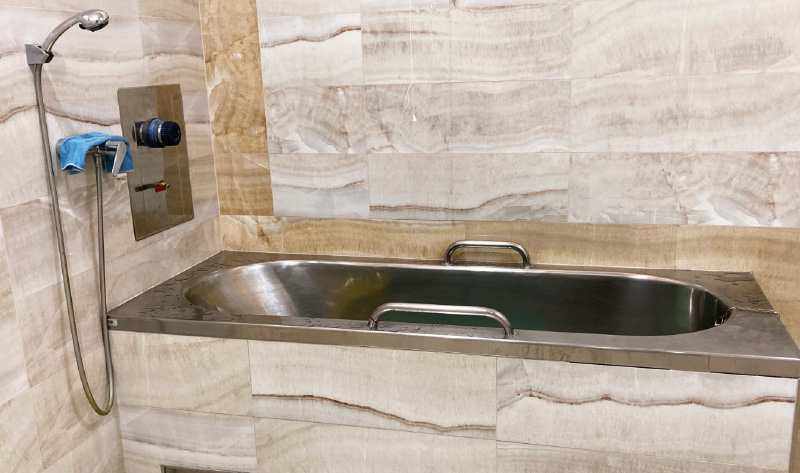
Fig. 28. Bathtub for radon bath
In addition to radon baths, patients usually receive bubble or additive baths, dry carbon dioxide baths, pool exercises (Fig. 29) and many other treatments depending on the type of illness. An integral part of the therapy are physiotherapy and massage, which, along with radon baths, is one of the finest treatments offered Jáchymov Spa has to offer (Fig. 30).
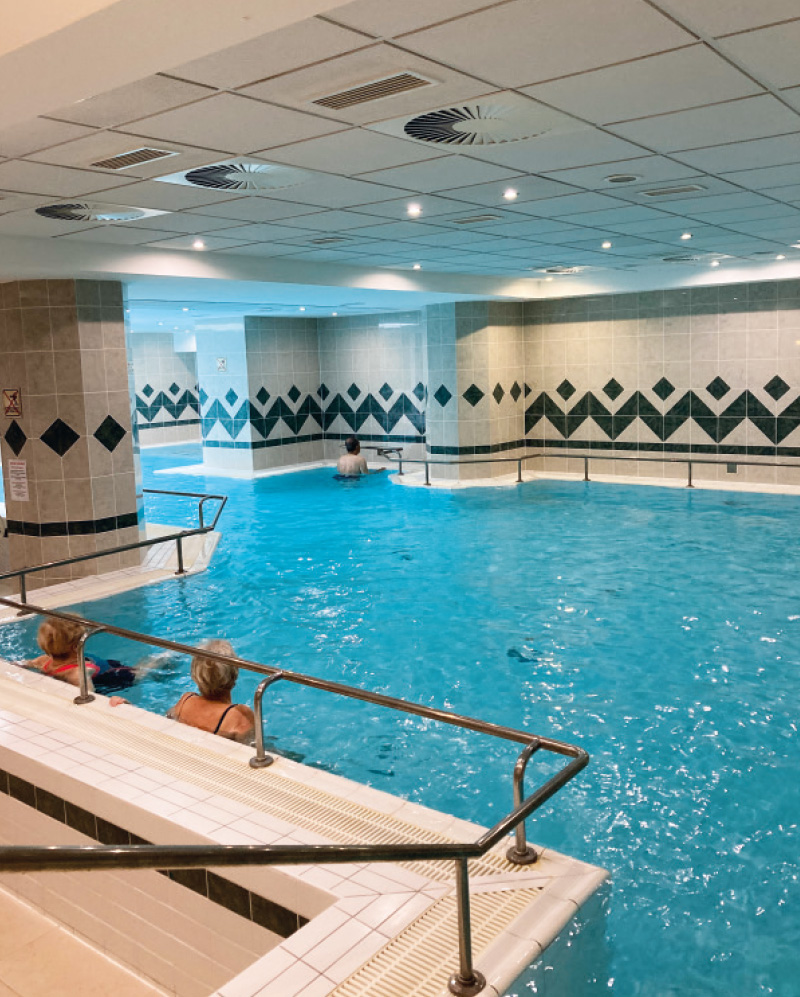
Fig. 29. Exercise in the pool
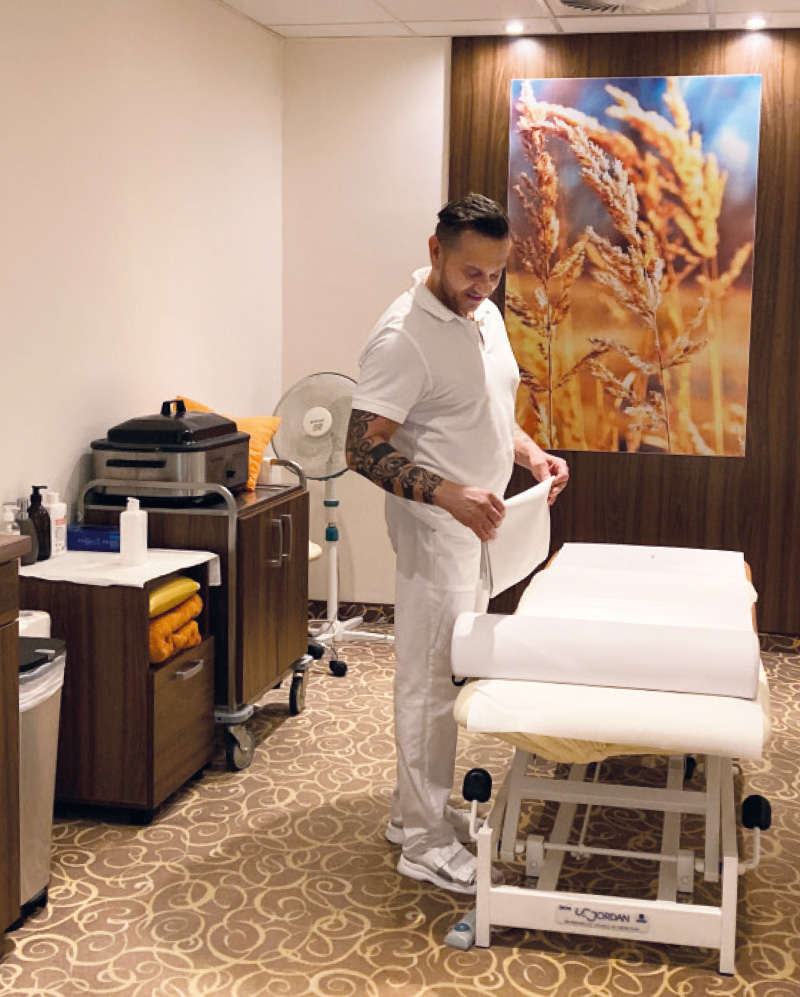
Fig. 30. Masseur Samuel Kolman
Finally, it is necessary to mention another Jáchymov unique feature, the so-called Jáchymov boxes, also known as brachytherapy (BRT). This involves irradiating the affected area (e.g., a joint, part of the spine, etc.) with ionizing radiation from close proximity. The radiation source used is radium-226. The treatment takes place in the Radiology Pavilion and results in significant pain relief. This therapeutic effect lasts for half a year to a year. Brachytherapy is carried out in only one place in the world – Jáchymov.
Acknowledgements
I would like to thank the Chief Physician of the Jáchymov Spa, MUDr. Jindřich Maršík, MBA, for his willingness to give me an interview about the local radon treatment. I must also thank MUDr. Radovan Kamenec, not only for his excellent care of my health, but also for his interest in my work. My great thanks go to the historian from Jáchymov, Ing. Jaroslav Ochec for his interesting lecture about Marie Curie-Skodowska and for giving me her photo from her visit to Jáchymov. I am aware of its value and I am very grateful for it. I would also like to thank the spa media representative, Jan Laufek, for his personal invitation to the international conference on the 100th anniversary of Marie Curie-Skłodowska’s visit to Jáchymov. It was a great honour for me to participate in it. I would like to thank Mr. Antonín Kreissl from the Jáchymov Spa Visitor Information Centre for his help and support. Many thanks to Radovan Přiklopil, the receptionist at the Radium Palace, to whom I am extremely grateful for his support in writing this article and for the book on the history of Jáchymov which he kindly gave me. Finally, I would like to thank all the spa staff at the Radium Palace Hotel who participated in my treatment. I appreciate their work very much.
An informative article that is not subject to peer review.
